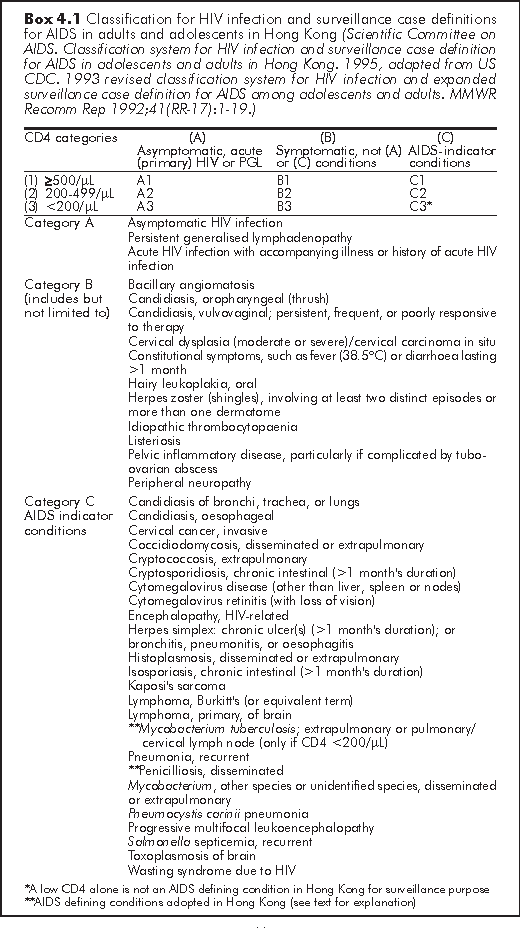
Ka-Hing WONG, Kenny CW CHAN
After acute infection, HIV disease enters a chronic life-long state of infection, which is characterised by a complex interplay between the virus and the host. With a variable asymptomatic duration, the final outcome for most, if not all, of the patients is the development of major complications followed by death, in its natural course of progression. Without effective treatment, clinical morbidity and mortality associated with HIV is the biggest medical problem for infected patients. Conceivably the spectrum of clinical presentations varies with the degree of immunodeficiency. Like other chronic disease conditions, such as cancers, different classification systems have been proposed. The purposes of such can be multi-fold, including assessment of prognosis, guidance to treatment initiation and disease surveillance. As such, classification of HIV disease appears to serve the dual role of supporting clinical management and the public health role of determining societal impacts.
In as early as 1982, before the discovery of its causative agent, the US Centers for Disease Control and Prevention (CDC) had developed a case definition for AIDS.1 The diagnosis was based on the detection of the "presence of diseases moderately indicative of underlying cellular immunodeficiency in a person without recognised cause", the latter referring to such examples as neoplastic disease and immunosuppressive therapy. In 1984, the term AIDS related complex (ARC) was coined to describe the symptoms of immunodeficiency that were being recognised with increased frequency in persons at risk for AIDS. They were unexplained generalised lymphadenopathy, idiopathic thrombocytopaenia, oral candidiasis, herpes zoster infection, and a constitutional wasting syndrome. This term is now obsolete.
In 1984-85, serological testing became available to confidently provide for the diagnosis of HIV in infected persons. In 1986,2 CDC defined a classification system to accommodate the increased number of clinical manifestations that had become associated with chronic HIV infection. This new system classified HIV infection into acute infection, asymptomatic infection, persistent generalised lymphadenopathy, and certain other categories. In 1987, CDC expanded its definition of AIDS in order to track more effectively the morbidity associated with HIV infection. This was revised and further expanded in 1993.3 Progression of disease is indicated by the detection of specifically defined opportunistic conditions. The CD4 count provides another marker for characterising the clinical stages. Generically, AIDS has since been defined as the laboratory diagnosis of HIV infection plus either an opportunistic infection or a CD4 count of below 200/μL.
Hong Kong has adopted largely the CDC 1993 classification4 (Box 4.1), but with the following modifications: (a) disseminated penicilliosis has been added as one AIDS-defining illness (ADI); (b) pulmonary or cervical lymph node tuberculosis is included only if CD4 <200/μL; (c) a CD4 <200/μL without any ADI is not counted as AIDS. This latter provision of not classifying AIDS based on CD4 count alone is similar to the European approach.5 Among the reasons for the deviation, the Hong Kong and European approaches have resulted as, unlike US, access to medical and social care is not conditional upon meeting the AIDS criteria. On the other hand, modification for Mycobacterium tuberculosis and inclusion of Penicillium marneffei have been made basing on the uniqueness of local disease epidemiology.
The classification of a patient as having AIDS serves primarily a public health function. The same classification schema is often used in comparing the clinical characteristics of cohorts. Albeit a useful clinical staging tool, there are a number of limitations. First, the various ADI each carries different prognostic implications. For instance, pulmonary tuberculosis and Kaposi's sarcoma may occur at a relatively high CD4 count with good prognosis, compared to cytomegalovirus diseases and penicilliosis against the background of severe immunodeficiency. Second, while staging is not reversible by definition, the progressively downhill course of AIDS patients can now be completely reversed with HAART.6,7 Prior AIDS does not adversely affect new AIDS development or non-accidental death after HAART, an observation that has been confirmed locally.8 As a consequence, disease course depends on access to HIV care more than natural progression nowadays.
There are other HIV classification systems. The Walter Reed staging system of HIV infection9 classifies patients on the basis of CD4 counts, skin-test responsiveness, lymphadenopathy, oral candidiasis and opportunistic infections. It has limitations with respect to predictive value. The World Health Organization (WHO) has also developed a case definition for AIDS that can be used in developing countries where sophisticated diagnostic technologies are not available.

Clinical conditions that arise from immune deficiency are highly diversified, depending on which organ/system is involved and the stage of the disease. In general, comparatively minor diseases may precede ADI. Classical examples of pre-AIDS illnesses include mucocutaneous conditions such as herpes zoster, oral thrush and oral hairy leukoplakia, the occurrence of which predict faster disease progression. Opportunistic infection is the commonest cause of ADI, followed by malignancies and HIV specific conditions. Overall, the respiratory system, gastrointestinal system and central nervous systems (Chapters 18, 19 and 20) are common sites of complications in HIV/AIDS.
As a rule CD4 count is the single most important tell-tale laboratory marker, the level of which correlates with the occurrence of the spectrum of opportunistic complications. The US CDC reported that over 80% of patients with ADIs (including Pneumocystis carinii pneumonia, oesophageal candidiasis, immunoblastic lymphoma and HIV encephalopathy) occur at a CD4 count <200/μL; and conditions like CMV retinitis, cerebral toxoplasmosis, disseminated Mycobacterium avium intracellulare and extrapulmonary cryptococcosis do not usually manifest until CD4 is below 50-100/μL.10 Nevertheless, the CD4 cell level of healthy Chinese adults appears to be lower than that of Caucasians, which could have bearing in disease staging, monitoring and even treatment. In a local study to establish lymphocyte subpopulations reference ranges in healthy Chinese adults, the mean were 725 cells/μL and 589 cells/μL, with a 95% reference range of 292-1366 cells/μL and 240-1028 cells/μL, for CD4 and CD8 T lymphocytes respectively.11 The mean CD4 and CD8 percentages were low when compared with healthy Caucasian persons.12 In a separate study that looked at natural immunologic and clinical disease progression before the HAART era, it also appeared that major opportunistic complications occurred at somewhat lower CD4 levels in Chinese patients.13 From a study on the clinical course of events and CD4 changes in a cohort of local patients again in the pre-HAART era, a different set of CD4 criteria was considered to stage HIV disease in Chinese.14 The study suggested that a CD4 of <100/μL (6%) and 100-220/μL (6-12%) corresponded to <200/μL (<14%) and 200-500/μl (14-28%) respectively according to US CDC staging.
Thorough assessment of a newly diagnosed HIV positive patient is essential, which serves the following purposes:
(a) Determination of disease stage and treatment strategy - this is done by history, physical and laboratory tests (Boxes 4.2 and 4.3)
(b) Education about risk reduction and lifestyle management - this involves the consideration of pregnancy, condom use, accommodation at work, disclosure (or not) of HIV status.
(c) Addressing issues unique to special groups - the needs of, for example, women, haemophiliacs, drug users and other marginalised communities should be noted.
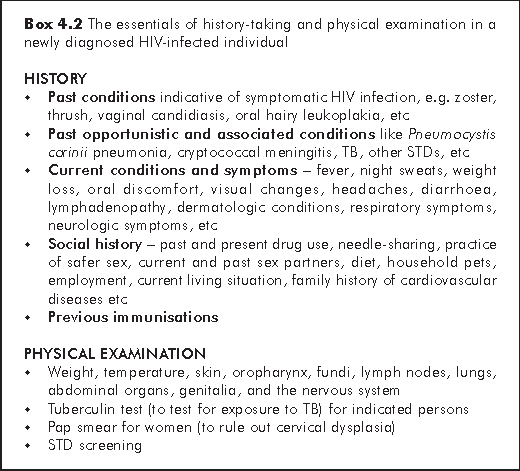
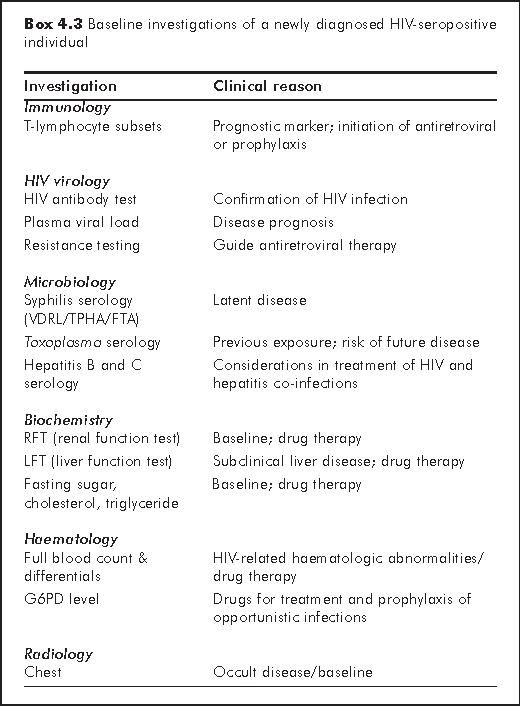
HIV disease progresses to AIDS after a median of 11 years. However, the rate of progression is very variable. There are long term survivors who are free of clinical AIDS after 20 years.15 On the other end of the spectrum, there are those who manifest AIDS and die within 2 to 3 years. Researches have been conducted to determine factors that influence the rate of disease progression. Both viral and immune factors are important (refer to Chapter 1) in this regard. Nevertheless, the two most commonly used parameters for disease prognosis and monitoring in day-to-day patient management are the CD4 lymphocyte count and viral load.
The search for a marker of disease progression began with the identification of β2-microglobulin, p24 and CD4 as prognostic markers in the early days. Then in the landmark study of Multicenter AIDS Cohort Study (MACS), a low baseline CD4 count and high viral load were found to predict time to AIDS.16
Measurement of CD4 - CD4 count is commonly measured by flow cytometry which uses specific monoclonal antibodies to determine the percentage of lymphocytes bearing the CD4 glycoprotein. The absolute CD4 count is calculated by multiplying this percentage and the total lymphocyte count. The CD4 count is widely variable, depending also on factors other than HIV (Box 4.4). To a certain extent, this variability may be countered by using the CD4 percentage instead; thus both values are useful. A significant change usually refers to that of more than 30% for absolute count, or 3% for CD4 percentage. Comparison is preferably made between CD4 counts obtained from blood drawn at the same time of the day.
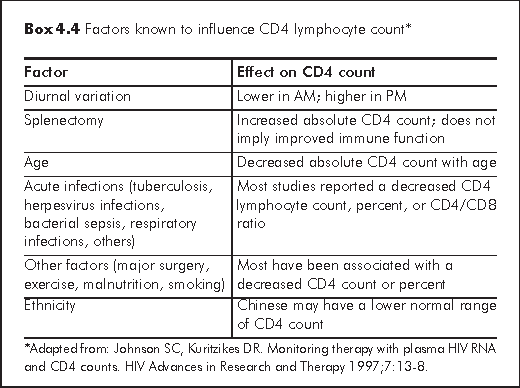
Measurement of viral load - Cell free HIV-RNA in plasma is best measured by the branched DNA technique - bDNA (Chiron) or reverse transcription polymerase chain reaction - RT-PCR (Roche). Nucleic acid sequence based amplification - NASBA (Organon) is not available in Hong Kong. At this stage of development, viral load testing is not an exact test yet, having a significant intratest variability of up to 0.3-0.5 log. Furthermore viral load results obtained by bDNA and PCR may not correlate with each other. Neither do results obtained with less and more sensitive (<50 copies/mL) versions of the same testing method. Factors affecting viral load measurements are in Box 4.5. To minimise the intrinsic variability of viral load tests, repeat measurement is indicated when the decision to initiate or change treatment is to be based on the results. Serial measurements are best made with the same methodology and with the same version of test. A rise or reduction in viral load is deemed significant only if it is more than 0.5 log. In practice, the most sensitive assay available is recommended, in recognition of the fact that the nadir of viral load suppression correlates with the durability of response. This is particularly important in managing patients on antiretroviral therapy.
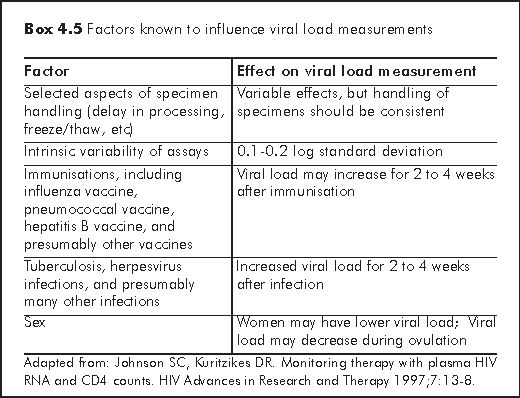
Viral load as tested by other techniques such as quantitative cell culture or plasma culture is also useful but expensive. Ultrasensitive cell culture techniques that stimulate CD4 lymphocytes into production of HIV allow the virus to be isolated even in those individuals with undetectable viral load in clinical practice. Their clinical utility is however uncertain, and is currently a research tool.
Overall, regular viral load monitoring provides useful information on the rate of disease progression. This, together with CD4 enumeration every three to four months is recommended for assessing individual patient. CD4 monitoring is more useful than viral load in untreated patients whereas the reverse holds for patients on antiretroviral therapy and should be closely followed. Overall, the indications for viral load testing are:17
(a) Use in conjunction with CD4 for decision to start or defer HAART
(b) Determining the virologic effectiveness of HAART and as a regular monitoring tool after initiation of treatment in chronic infection
(c) Supporting the presumptive diagnosis of acute HIV infection
Centers for Disease Control (CDC). Update on acquired immune deficiency syndrome (AIDS)--United States. MMWR Morb Mortal Wkly Rep 1982;31:507-8, 513-4.
Classification system for human T-lymphotropic virus type III/lymphadenopathy-associated virus infections. Centers for Disease Control, U.S. Department of Health and Human Services. Ann Intern Med 1986;105:234-7.
1993 revised classification system for HIV infection and expanded surveillance case definition for AIDS among adolescents and adults. MMWR Recomm Rep 1992;41(RR-17):1-19.
Scientific Committee on AIDS. Classification system for HIV infection and surveillance case definition for AIDS in adolescents and adults in Hong Kong. Hong Kong: Advisory Council on AIDS, 1995.
Ancelle-Park R. Expanded European AIDS case definition. Lancet 1993;341:441.
Wong KH, Chan KC, Lee SS. Delayed progression to death and to AIDS in a Hong Kong cohort of patients with advanced HIV type 1 disease during the era of highly active antiretroviral therapy. Clin Infect Dis 2004;39:853-60.
Chan CW, Cheng LS, Chan WK, Wong KH. Highly active antiretroviral therapy per se decreased mortality and morbidity of advanced human immunodeficiency virus disease in Hong Kong. Chin Med J (Engl) 2005;118:1338-45.
Wong KH, Chan KCE, Cheng LS, Chan WK, Kam KM, Lee SS. Establishing CD4 thresholds for HAART initiation in a cohort of HIV-infected adult Chinese in Hong Kong. AIDS Patient Care STDs. (in press)
Redfield RR, Wright DC, Tramont EC. The Walter Reed staging classification for HTLV-III/LAV infection. N Engl J Med 1986;314:131-2.
Hanson DL, Chu SY, Farizo KM, Ward JW. Distribution of CD4+ T lymphocytes at diagnosis of acquired immunodeficiency syndrome-defining and other human immunodeficiency virus-related illnesses. The Adult and Adolescent Spectrum of HIV Disease Project Group. Arch Intern Med 1995;155:1537-42.
Kam KM, Leung WL, Kwok MY, Hung MY, Lee SS, Mak WP. Lymphocyte subpopulation reference ranges for monitoring human immunodeficiency virus-infected Chinese adults. Clin Diagn Lab Immunol 1996;3:326-30.
Reichert T, DeBruyere M, Deneys V, et al. Lymphocyte subset reference ranges in adult Caucasians. Clin Immunol Immunopathol 1991;60:190-208.
Wong KH, Lee SS, Kam KM. Decline of CD4 level and its correlation with clinical events in Chinese HIV-infected patients. J Infect Dis Antimicrob Agents 1998;15:99-103.
Kam KM, Wong KH, Li PC, Lee SS, Leung WL, Kwok MY. Proposed CD4(+) T-cell criteria for staging human immunodeficiency virus-infected Chinese adults. Clin Immunol Immunopathol 1998;89:11-22.
Phillips AN, Sabin CA, Elford J, Bofill M, Janossy G, Lee CA. Use of CD4 lymphocyte count to predict long-term survival free of AIDS after HIV infection. BMJ 1994;309:309-13.
Mellors JW, Munoz A, Giorgi JV, et al. Plasma viral load and CD4+ lymphocytes as prognostic markers of HIV-1 infection. Ann Intern Med 1997;126:946-54.
US DHHS. Guidelines for the use of antiretroviral agents in HIV-infected adults and adolescents. Available from www.hivatis.org, October 10, 2006.